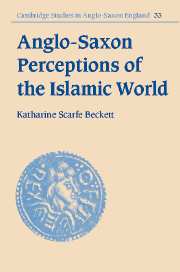Book contents
- Frontmatter
- Contents
- Acknowledgements
- List of abbreviations
- 1 Introduction
- 2 Islam during the Anglo-Saxon period
- 3 Anglo-Saxon contacts with Islam
- 4 Arabs and Arabia in Latin
- 5 Ismaelites and Saracens in Latin
- 6 Arabs, Ismaelites and Saracens in early Anglo-Latin
- 7 Pseudo-Methodius and the sons of Ismael
- 8 Arabs, Ismaelites and Saracens in Old English
- 9 Persisting theories about Saracens in post-Conquest England
- 10 Conclusions
- Bibliography
- Index
4 - Arabs and Arabia in Latin
Published online by Cambridge University Press: 22 September 2009
- Frontmatter
- Contents
- Acknowledgements
- List of abbreviations
- 1 Introduction
- 2 Islam during the Anglo-Saxon period
- 3 Anglo-Saxon contacts with Islam
- 4 Arabs and Arabia in Latin
- 5 Ismaelites and Saracens in Latin
- 6 Arabs, Ismaelites and Saracens in early Anglo-Latin
- 7 Pseudo-Methodius and the sons of Ismael
- 8 Arabs, Ismaelites and Saracens in Old English
- 9 Persisting theories about Saracens in post-Conquest England
- 10 Conclusions
- Bibliography
- Index
Summary
Adomnán's De locis sanctis implies but does not state that the Saracens might have come from Arabia. As mentioned earlier, readers of Latin in the early medieval period understood the word ‘Saracen’ as a contemporary term for the Old Testament peoples of the Ismaelites or Hagarenes. These tribes were described in the Bible and biblical commentaries as inhabitants of the areas south and east of the Holy Land. An Anglo-Saxon reader well versed in biblical commentary would have seen in the Ismaelites a connection between the contemporary Saracens and the region of Arabia beyond the Jordan, both mentioned in Adomnán's De locis sanctis.
It should be emphasised that such a connection could only have been made by an educated Christian. Clear links between Arabia, Ismaelites and Saracens survive only in Latin exegetical texts. But even Latin exegetes did not, as a rule, describe the Saracens as an Arab people. Direct links between the Saracens and Arabia are rare compared with links between Saracens and Ismaelites, on the one hand, and between Ismaelites and Arabia, on the other. The Arabs and Saracens seem to have been thought of in separate contexts. Arabs were mentioned not only in the Bible but also in classical writings, whereas the Ismaelites were only known from the Old Testament and Christian writings, and the Saracens only from works written after the second century AD. The Anglo-Saxons, however, first encountered all three peoples in the same Latin Christian context.
- Type
- Chapter
- Information
- Anglo-Saxon Perceptions of the Islamic World , pp. 69 - 89Publisher: Cambridge University PressPrint publication year: 2003

